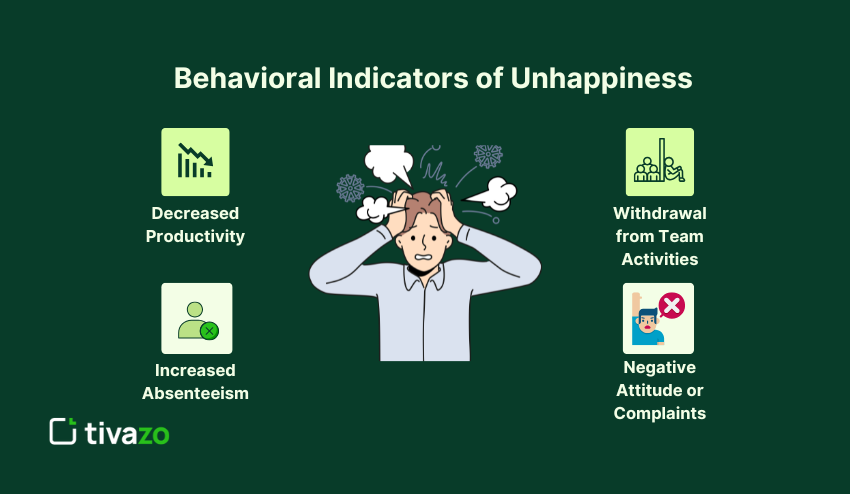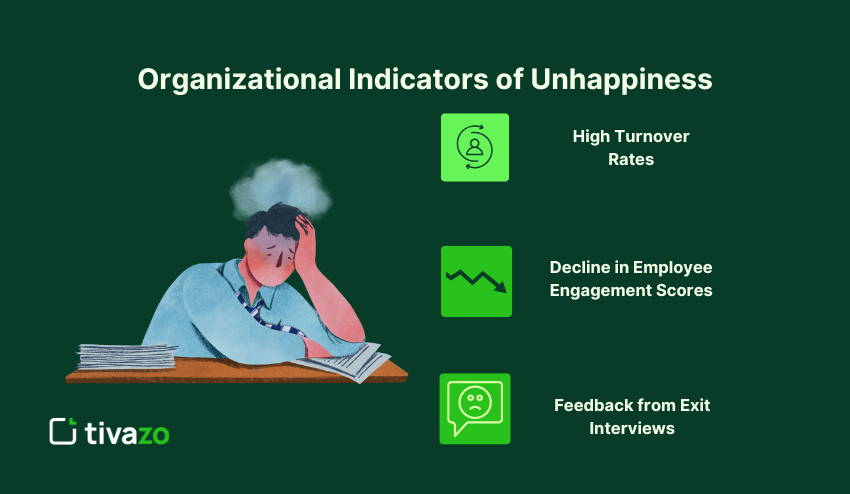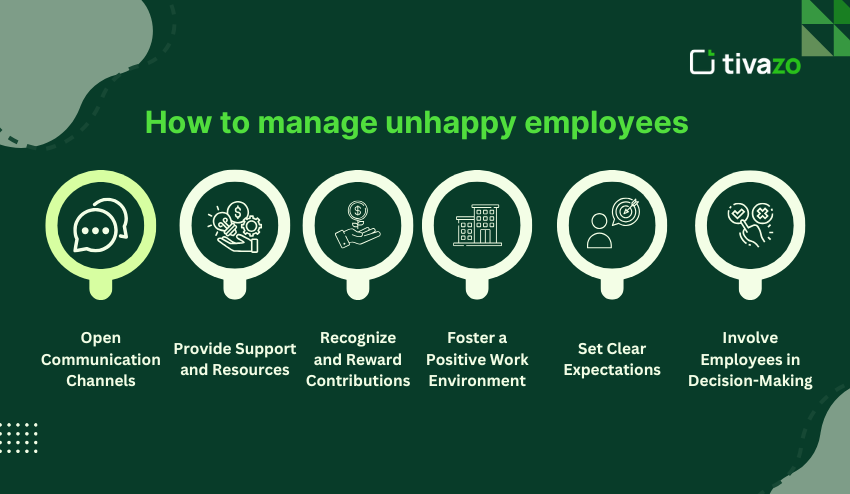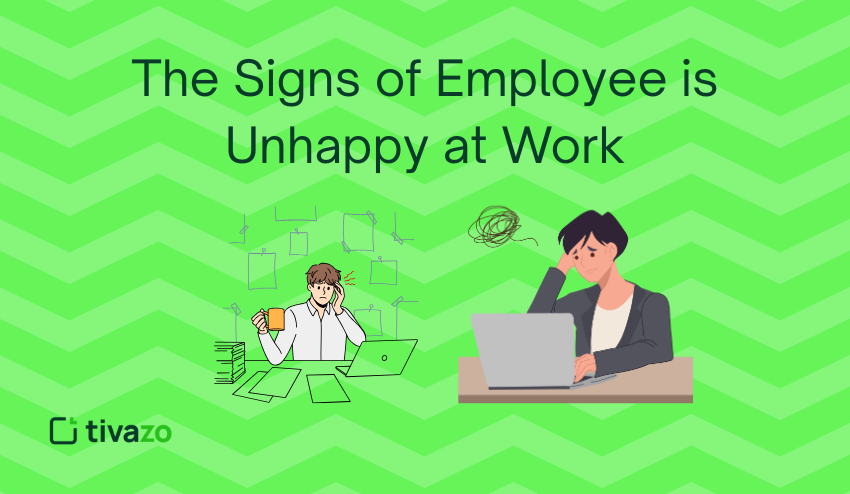“An employee’s silence can be louder than their words.” In many cases, minor behavioral, attitude, or engagement changes are indicators that something is wrong. It is important that managers are aware of these signs early. Dissatisfaction that is not addressed can easily result in disengagement, reduced productivity, and even turnover.
It is important to understand the reason behind employees getting unhappy. Workload or pay is seldom the only issue. This can be caused by such factors as the absence of recognition, unclear expectations, insufficient growth opportunities, or a poor workplace culture. Managers are therefore able to solve the cause of the problem and not the symptoms after identifying these underlying causes. This is a proactive measure to keep the employees motivated, engaged and in line with team objectives.
This guide will show you how to recognize the most common signs of employee is unhappy, how this negatively affects your team and organization, and what you can do to manage unhappy employees before it gets worse. By observing these signs, you will be able to have a motivated, productive, and high-performance workplace.
Behavioral Indicators of Unhappiness
The first observable symptoms of an employee who is in trouble are usually behavioral changes. These signs may be minor in the beginning, but they gradually increase. Observing the daily activities and interactions, managers are able to see the early warning signs and act before the dissatisfaction is beyond control.

1. Decreased Productivity
The inability to meet deadlines, provide quality work, or accomplish the tasks that they used to do effectively may be a sign of disengagement when it is a consistent pattern with an employee. Decreases in productivity are usually caused by a mixture of lack of motivation or dissatisfaction with the job or believing that they are not valued. This might be a sign of quiet quitting. This strategy can be used to determine whether the dips are temporary or true indicators of unhappiness.
2. Increased Absenteeism
Chronic lateness, unaccounted absence or long breaks are usually indicators of dissatisfaction. Occasional absence is normal but regular patterns can be an indication of stress, burnout or lack of engagement. They can also exhibit disengaged behaviors even when physically present in the workplace by their employees who seem to be physically present but not mentally. This is one of the signs of Employee is Unhappy at the workplace.
3. Withdrawal from Team Activities
Dissatisfied workers tend to shut themselves off in terms of social or teamwork. They can refuse to attend team meetings, avoid informal meetings, or refuse to undertake any collaborative projects. This may be a gradual withdrawal, but it may have adverse effects on the cohesion of a team when left unchecked. Managers can identify these signals early by observing the involvement in meetings and brainstorming sessions as well as cross-functional projects.
4. Negative Attitude or Complaints
Dissatisfaction may be manifested by a change in attitude towards constant complaints, cynicism, or a generally negative attitude. Although constructive feedback is helpful, it is possible to demotivate the team with continuous negativity and disrupt the teamwork, which will impact the overall performance. One should understand the difference between a temporary frustration and a habitual tendency to negativity.
By paying attention to these behavioral signs of employee is unhappy, managers can intervene before dissatisfaction spreads.
Emotional and Psychological Signs of Employee is Unhappy
Behavioral changes are usually accompanied by emotional and psychological indicators that give more information on employee satisfaction. Although behavioral signs are easier to detect, emotional signs will show how the employees actually feel about their jobs and the environment. By identifying these cues in time, managers can be able to offer assistance in time before disengagement escalates.
1. Increased Stress or Anxiety
Stressed employees can be tense, distracted, or easily overwhelmed. The stress may be in the form of inability to focus, indecisiveness, or making errors. Anxiety can also be in the form of refusal to speak during meetings or shirking of duties. Chronic stress not only impacts the personal health of the individual but also decreases the productivity of the whole team.
2. Lack of Enthusiasm
A significant decline in energy or interest in work is a good indicator of disengagement. Previously proactive and motivated employees can begin to show only minimum effort, stop volunteering to work on new projects, or show no interest in career growth opportunities. This disengagement may be an indication that their talents or efforts are under-valued or not in line with the expectations.
3. Emotional Outbursts
Mental Fatigue may be manifested by irritability, sudden mood swings, or unexplained frustration. These signs can be identified, and therefore, managers can deal with the root causes. Therefore, urgency is a must to manage unhappy employees.
Significant productivity problems are usually preluded by emotional and psychological signs. Early intervention can stop things before they get out of hand and indicate to employees that they are important.
Physical and Behavioral Changes
Signs of employee is unhappy can be seen through physical signals and daily habits. Although the behavioral and emotional symptoms can show the mental condition of an employee, physical changes can give a visible sign that something might be wrong with his well-being. With these indicators, managers will be able to interfere early and provide assistance before the performance problems get out of control.
1. Changes in Appearance or Grooming
One of the reasons why employees may abruptly lose interest in their personal appearance, hygiene, or professional attire may be stress, burnout, or disengagement. This could be in terms of always wearing wrinkled clothes, appearing less presentable, or generally appearing to be tired. Not every physical appearance change is necessarily a work-related issue but grooming patterns that shift dramatically in a large group of employees may be a clue to a bigger morale or culture issue.
2. Decline in Health
Stress in the workplace is mostly physical. Constant headaches, tiredness, stomach problems, or other stress-related illnesses are some of the signs that indicate dissatisfaction. Health decreases can also be very subtle, like loss of energy, frequent yawning or even outward signs of fatigue. Monitoring trends in health-related absenteeism or repeat complaints are early signs of employee is unhappy.
3. Increased Use of Leave
Workers who start taking too many sick days, personal days, or extended vacations are possibly trying to escape stressful work situations. It is usual to take the occasional leave, but repeated or any pattern of absence is usually an indication of disengagement or dissatisfaction. This attitude may influence the work process in a team, putting more pressure on other team members and lowering productivity.
By combining observations of behavior, emotion, and physical cues, managers can create a comprehensive view of employee well-being.
Organizational Indicators
Unhappiness is not always limited to individual workers, but it may spread to teams or departments. The signs of employee is unhappy that may be observed on the organizational level may provide a brilliant idea about some of the systemic issues that may be affecting morale, engagement, and overall productivity. Monitoring these broader signs helps leaders to address the causes and not just the symptoms.

1. High Turnover Rates
High turnover of employees is usually an indication of dissatisfaction with the management, the culture of the work environment, or the allocation of work. High turnover does not only mean more recruitment and training expenses, but also it interferes with team unity and delays the current projects. The trends of exiting certain teams or positions can reflect more underlying problems like leadership, a lack of expectations, or a lack of career growth opportunities.
2. Decline in Employee Engagement Scores
A handy method of gauging general job satisfaction is frequent surveys. Low scores on a regular basis show that there is a general lack of happiness, disengagement, or a disconnect between workers and management. These can be signs of employee is unhappy. Survey data trends, e.g., decreasing motivation, lack of trust, or dissatisfaction with recognition, can be used to indicate areas that require immediate attention.
3. Feedback from Exit Interviews
Exit interviews tend to show common problems that lead to dissatisfaction among the employees. The general issues can be poor management, lack of growth opportunities, poor communication or lack of recognition. Taking action based on these insights can prevent such problems in the future to other employees as well as enhance retention in the long-run.
Tracking organizational indicators complements individual observations, giving a fuller picture of workplace satisfaction.
What happens when employees are not happy?
The consequences of ignoring signs of employee is unhappy at work can be long-term to both individuals and the organization. Being aware of such effects explains why early intervention and active management are crucial. Let us see what happens when employees are not happy.
1. Reduced Productivity
Employees who are not engaged will work at a slower pace and are more likely to make errors. Even the most talented members of the team can perform poorly in case of low morale, which directly decreases the effectiveness of the team as a whole. Long-term disengagement may cause bottlenecks in the workflow, slow down the schedule of the project, and overload other workers. Failure to manage unhappy employees results in low productivity.
2. Decreased Morale
A single dissatisfied employee may affect the energy and attitude of the other employees in a ripple effect. Low morale teams tend to have less teamwork, more fights and no will to go the extra mile. This negative environment can be normalised over time, and this also influences engagement. This is one of the signs of employee is unhappy.
3. Higher Turnover
Dissatisfied employees are highly likely to quit their jobs and this leads to high turnover rates. Replacing people is resource-intensive, time-consuming, and disrupts continuity and team dynamics. High turnover will also affect the remaining employees as they could be stressed and will have more work to do.
4. Customer Experience
Employees who are disengaged will not deliver high quality service consistently. Errors, slow service or lack of interest are all things that can hurt customer satisfaction and may result in complaints, loss of business and a lack of loyalty. If you do not manage unhappy employees, it will hamper the customer experience.
5. Organizational Reputation
Constant dissatisfaction influences both internal and external culture. Firms that have disengaged employees will find themselves at risk of being negatively perceived, and it will be difficult to recruit the best talent. Leadership credibility can also be destroyed by a bad workplace culture that can destroy organizational development.
Recognizing the potential consequences highlights why addressing dissatisfaction early is essential. These points tell you what happens when employees are not happy.
How to manage unhappy employees
The key to successfully dealing with signs of employee is unhappy is a proactive strategy that integrates communication, support, and empowerment. The introduction of effective measures will not only eliminate the current dissatisfaction but will also avoid future disengagement. Here are some measures to take when you find out the signs of employee is unhappy.

1. Open Communication Channels
One-on-one meetings on a regular basis enable the employees to express concerns, difficulties, or frustrations in a secure setting. Listening shows that they are heard and that managers can receive useful information on the issues that lie beneath engagement. Trust and employee-manager relationships are also established through open dialogue.
2. Provide Support and Resources
The provision of counseling, mentoring, coaching, or stress management programs is an indicator that the organization cares about its workers. When the correct resources are provided, employees will be able to deal with challenges successfully, enhancing their resilience and motivation.
3. Recognize and Reward Contributions
Acknowledging achievements boosts, rewarding success will raise morale and will strengthen the worth of the effort of every employee. Recognition may be in the form of team meetings, but it may also be in the form of a personal note or email. Frequent recognition promotes participation, retention, and an increased level of performance. It is a big step to manage unhappy employees.
4. Foster a Positive Work Environment
An organization with a culture of respect, inclusivity, and work-life balance will decrease stress and encourage engagement. Supportive environments promote cooperation, innovation, and problem-solving and reduce friction and conflict, and help manage unhappy employees.
5. Set Clear Expectations
The best performance of employees occurs when they know their roles, duties, objectives, and standards of performance. When there is no clarity, confusion, frustration, and disengagement tend to occur. Well-articulated expectations provide employees with direction and quantifiable goals to work on.
6. Involve Employees in Decision-Making
Asking input on processes, projects and team initiatives makes one feel a sense of ownership and responsibility. When employees feel that they are heard they will be more willing to remain engaged, take initiative and contribute solutions as opposed to instructions.
Conclusion
Being able to identify the signs of employee is unhappy is an essential practice to ensure that the employee remains productive, engaged, and retained. Employee satisfaction can be captured through behavioral, emotional, physical, and organizational indicators.
Being aware of these signals and using preventive measures through positivity, communication and support, recognition and encouraging the culture managers will be able to keep turnover down, the morale high, and the performance of the team within oneself. Early intervention keeps the employees motivated, engaged and productive.
Well-being is a win-win situation to the workplace. Following through with these understandings makes a competent team that functions effectively, provides high quality service and is able to facilitate long time organizational success.




